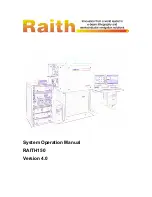
Describing the PCS2 Device Components
2-11
P/N 85266-30, Manual revision: A
Air detectors
The PCS2 is equipped with an assembly of ultrasonic sensors designed to detect
the presence of air, bubbles or foam in the fluids flowing through the disposable
set tubing. If air is detected outside of the normal range during any mode (PRIME,
DRAW OR RETURN), the detectors will:
z
Alert the PCS2 safety system.
z
Stop the operation in progress.
z
Provide the operator with an error message and an audible alarm.
Figure 2-8, Example of a PCS2 air detector
Anticoagulant Air Detector (ACAD)
The passage of anticoagulant solution from the bag into the PCS2 system occurs
over a series of steps. The ACAD will monitor the AC solution line throughout the
entire procedure.
The ACAD is located on the top deck of the PCS2 cabinet adjacent to the AC
pump and will function once the AC solution has passed through the AC pump
tubing.
Blood Line Air Detector (BLAD)
This air detector, located on the top deck of the PCS2 cabinet to the right of the
blood pump, will serve a dual purpose to the operator. The BLAD will remain
active throughout the entire procedure, but will provide a specific function at the
following moments:
z
During a Draw cycle, the BLAD will detect the presence of fluid passing
through the blood line tubing. This allows the system to account for the
volume of blood being pumped.
z
During a Return cycle, the BLAD will note the presence of any air in the
tubing leaving the centrifuge bowl. This line contains the blood being re-
turned to the donor and will pass through the donor valve after the
BLAD. When the BLAD has detected air in the tubing within normal lim-
its, this will signal that the bowl is empty and the Return cycle will be
terminated.
Warning: Air detected (or lack of air detection) by the BLAD, outside of normal
limits, will stop the collection procedure and alert the operator.
















































